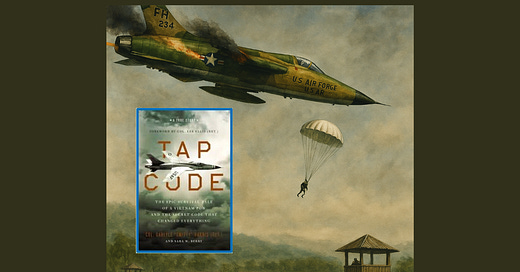The Tap Code: A Vietnam POW’s Guide to Enduring with Honor
More than a war memoir – The Tap Code is a lesson in faith, unity, and unbreakable spirit from a generation that refused to surrender.
On April 4, 1965, over North Vietnam, Captain Carlyle “Smitty” Harris ejected from his damaged F-105 Thunderchief and floated to the ground, becoming the sixth American prisoner of war (POW) thinking that “in one split second, I passed from the known to the unknown.” What followed was a harrowing ordeal lasting 2,871 days—nearly eight years—of brutal confinement, torture, and psychological warfare at the hands of his North Vietnamese captors.
In Tap Code, Harris recounts his journey with exceptional clarity, weaving together the deeply personal with the profoundly collective. Torture was common, and the Geneva Conventions were flagrantly ignored, as the North Vietnamese labeled American airmen political criminals rather than POWs. As one of the longest-held POWs, Harris is uniquely positioned to convey the full arc of the POW experience—from their brutal treatment to the evolution of their organization and solidarity, frustrating their captors at every turn.
More than a memoir, this book is a tribute to the hundreds of American POWs who endured the unthinkable during the Vietnam War. Through Harris’s eyes, readers gain an intimate understanding of how these men, bound by duty and the Code of Conduct, defied their captors and upheld their honor through resistance, communication, and unbreakable camaraderie.
On February 12, 1973, Harris was in the first group of POWs in Operation Egress Recap—later known as Operation Homecoming—to step off a U.S. transport aircraft onto the tarmac at Clark Air Force Base in the Philippines. As an 11-year-old, I vividly remember watching the television coverage of the men walking off the aircraft just a few short hours from their captivity in Hanoi. They cried tears of pride in their regained freedom. I didn’t know their individual stories, but I knew what they represented. I remember seeing them disembark, dressed in muted clothing; their names were announced one by one as they were greeted by officials. While I understood that their return was historic, I could not yet grasp the scale of their sacrifice or the depth of their struggle to frustrate the enemy, to live on their own terms, and ultimately, to return with honor in a hard-won victory.
Keep reading with a 7-day free trial
Subscribe to The Military Reading Room - History, Strategy, and Insight to keep reading this post and get 7 days of free access to the full post archives.





